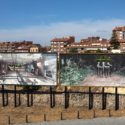A few weeks ago opened Spanish artist Gonzalo Borondo a new and exciting exhibition running under the name INSURRECTA and organized alongside with the City Council of Segovia in collaboration with the organisation Acción Cultural Española (AC/E).
According to the organisers, the project commemorates the city’s 500th anniversary of the so-called Revolt of the Comuneros, an uprising by citizens of Castilla against the rule of Charles I and his administration between 1520 and 1521.
About the project
IINSURRECTA (feminine for insurrecto, the Spanish word for insurgent) has been conceived as a series of works painted on billboards and located outside the tourist circuit of Segovia. A total of 32 works, distributed along 17 easily accessible locations, transform the urban and natural landscape into an open-air museum ready to be discovered.
Having this in mind, visitors are provided with a map showing the different locations, each of which includes an account of the revolt that took place 500 years ago. There is no specific route or direction, offering full flexibility and encouraging visitors to create their own.
At the same time, the artist shows the visitor a visual space of Segovia less known among tourists, promoting the visibility of the so called ‘No Places’.
The background
INSURRECTA not only pays homage to the Comuneros and their fight, but also to Goya’s well known series of engravings “Los caprichos” and “Los desastres”, and the way he denounced the atrocities of war. Borondo does so by making use of the monotype technique, applied to the project as a whole.
INSURRECTA is also an analysis of power struggles; not only in society, but also humanity confronting nature, the discourse of the urban in
the natural landscape and the re-appropriation of spaces by different agents or changes in the status quo.
The project seeks an exercise in critical thinking and reflection through the
interaction between visual metaphors and historical narrative. Moreover, the choice of support is not accidental, Borondo connects the reappropriation of land by the Comuneros with the reappropriation of art on public fences
The project as a whole involves different techniques, but one feature is common to all of them; the monotype technique that uses the tools of engraving but generates only one copy.
To make each work an experience in itself, the artist applies various plastic
techniques that condense or expand the content of the works beyond the platform they have been created on: iron sculptures and micro-perforated panels overflow some of the frames; cyanotype in search of a dreamlike realism typical of the first photographs; the use of animation in others expands the project beyond the original surface and, of
course, the juxtaposition of the fence itself with its surroundings, plays with the perspectives and landscapes of the area, becoming part of the work.
GONZALO BORONDO
Borondo began his career as a muralist in 2007. His projection of contemporary art in public spaces attempts to break down the barriers between art and life, questioning the limits of the cultural heritage of the context, while paying respectful homage to it. Borondo’s work is the result of a powerful dialogue between his art and the spaces in which it is located.










You must be logged in to post a comment.